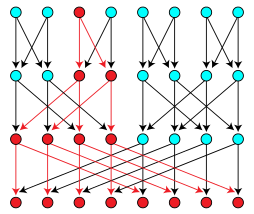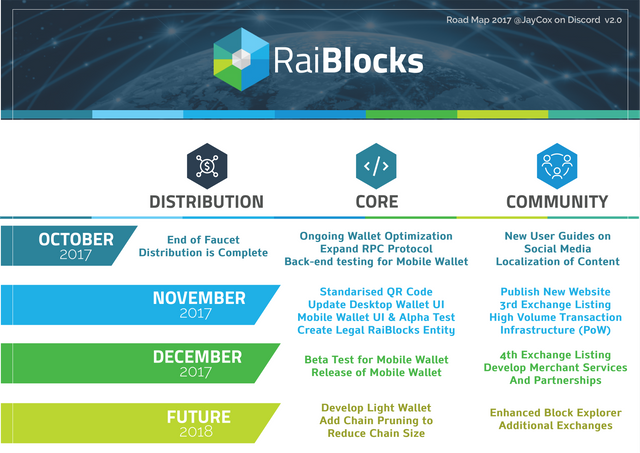Crypto Review - RaiBlocks (XRB) a Promising DAG.
In one of my latest articles I did a review about ICON (ICX) and in that article I said that I don't often do reviews of new cryptocurrencies because I find the work to be quite time intensive and beyond that also find it difficult to pick a single project out of an ocean of many.
But, with that said, I'd like to give my readers the first shot at an amazing token opportunity and that may require me to go above and beyond in terms of speed and quality in an effort to help those who have supported me.
So, here we go... Have you ever heard of a new token called RaiBlocks (XRB)?
I thought not. Let me explain...
What is RaiBlocks (XRB)?
RaiBlocks is a shared cryptocurrency and open source programming venture like Bitcoin with a much more advanced structure. It has been designed to optimize low inertness, high throughput and a fee-free transaction model. It is a digital currency that has been designed for scalability.
RaiBlocks is part of a new generation of cryptocurrencies gaining popularity; a generation of fast, feeless, minerless cryptocurrencies (FFM for short). There are a few contenders in this category Steem, IOTA and EOS (They are due to launch their own blockchain soon so expect big things).
Image of DAG (Directed acyclic graph) via Wikipedia.
RaiBlocks uses a crypto architecture they call “block lattice”. This is explained in detail on their wikipedia page which I recommend reading.
RaiBlocks isn’t a single long blockchain, like Bitcoin or Ethereum; it is a database of blockchains where each user (or address) gets their own blockchain that only they can add onto.
To explain further, users send funds by creating two blocks: one send block on their personal blockchain and one receive block on the recipient’s blockchain. Users receive funds by “pocketing” any outstanding receive blocks into their personal blockchain.
Don't worry, users don't have to be online to receive funds (this has been a worry brought up by users asking about RaiBlocks’ novel “pocketing” system).
RaiBlocks handles the receiving part of the transaction when the user decides to access their funds. At the time of access, the wallet itself will automatically “pocket” any outstanding funds. Pocketing funds just means signing the receive block with your private key, so that it can be added to your personal blockchain.
If you aren't familiar with all this tech talk its ok. Just know that we are looking at a contending technology to replace Web 2.0 as the new king of the jungle, Web 3.0.
RaiBlocks are in direct competition with IOTA and they both work in a similar but different manner. To provide an example, with IOTA, transactions get attached to the “tangle”, which is a directed-acyclic-graph (DAG) data structure. (Git works using this same data structure!)
As more transactions get added to the tangle, a “weight” is added to attached ancestor transactions. When a transaction has enough weight, the transaction will exhibit a “confirmed” status. In principle, this confirmation could be as quick as seconds when there is a sufficient flow of transactions across the network.
In RaiBlocks, there is a different confirmation system based on “representatives”. In general, all that is needed is your cryptographic signature on your “send” and “receive” blocks. When the node syncs, it runs through the ledger to ensure that the signatures are authentic.
This seems to be a major advantage that RaiBlocks has over IOTA although both are considered DAGs.
According to my source, RaiBlocks has excellent API support. They have RPC libraries, for interacting with nodes in Javascript, Python, PHP, and Elixir.
Where did the RaiBlocks tokens come from?
RaiBlocks is a “pre-mined” token. This means that their ledgers started out with a certain amount of cryptocurrency that can never change. Over time, these tokens have been bought, sold, and moved around with ICOs and Faucets, increasing the general users’ attainment of these cryptos.
This is something I'm not very hot on but their biggest competitor IOTA did the same thing so I'm not bothered by this too much...
Interesting Technical Facts about RaiBlocks
Ready for some math? The max supply of RaiBlocks is on the order of 2¹²⁸ ~ 340e36, or 340 undecillion. The reason this is such a large number is because they utilize a 128 bit integer to represent balances. (This may actually be a good thing.)
Their actual max supply is about 133,248,290 MXRB, where 1 MXRB represents 10³⁰ (or 1 nonillion) raw RaiBlock units. The max supply can be denoted as roughly 133e36, or 133 undecillion raw RaiBlocks.
Want to see a really big number? This is the numerical value for max supply in raw units:
133,248,290,000,000,000,000,000,000,000,000,000,000.
That’s 39 digits! For comparison, this means there are about 48 sextillion raw RaiBlocks for each and every IOTA that could ever exist. Now thats an interesting ratio!
Why I am so impressed with RaiBlocks...
Imagine that our world has 75 billion IoT devices by 2025. The world we are imagining has billions of people owning cryptocurrencies by 2025.
Lets also presume to think that these IoT devices own all the crypto. Now, if my calculations are correct, the average amount of crypto that will be shared among these future 75 billion devices will be on the order of 37 thousand IOTA (or 37 kIOTA) or 1.78 octillion raw RaiBlocks (or 1.78 kXRB).
What this means is that RaiBlocks will be much more flexible in a transactional sense. Therefore it is very likely that RaiBlocks has a real opportunity to dominate the IoT space in the coming years. This will most likely happen unless IOTA upgrades their protocol to either increase the max supply or allow for divisible IOTAs.
Techblogger Wrap Up
I learned quite a few things in the process of writing this article and I'd like to summarise the main things I've learned about RaiBlocks here:
1.) They are state of the art, they operate one of the only DAG blockchain type systems and have very few competitors.
2.) They are built for maximum speed and scalability. They are built for the IOT.
3.) They have modernized some of IOTA's best practices and advanced upon their technology using a few very interesting approaches.
4.) Very few people know about them yet so we are ahead of the game if we want to fill our bags.
Disclaimer: I have not invested in RaiBlocks yet but I'm in the process of doing additional research and believe this may be a good investment at the moment.
I hope you enjoyed reading this. Please leave your thoughts and comments below!
Thanks for dropping by @techblogger
Source:
Image Source:



Thanks for the detailed insight. I am seeing great potential in this coin.
RaiBlocks certainly is an interesting project, I wrote about it a week ago or so and regret not getting it back then! But I considered it to be a gamble, and didn't like how you had a minimum withdrawal of 100 RAI, on exchanges I'd rather not touch if I could avoid it.
I must disagree with your analysis of RaiBlocks, at least in part, though! You mention RaiBlocks alongside IOTA as if they are competitors, which they really aren't at all. They use similar technology, different from blockchain, but the difference between them is in their function: IOTA is meant for an Internet-of-Things world to create a machine economy where one machine can pay another machine.
RaiBlocks on the other hand focuses on one thing only: peer-to-peer payment between humans.
I believe RaiBlocks is making an attempt at digital cash whereas IOTA is making an attempt at machine economy. A lot of IOTA investors misunderstand this, I believe, and I personally don't believe we'll be ordering coffee with IOTA.
Similarly, RaiBlocks won't be used for the machine economy (much), for the same reason that Bitcoin won't. It's just not meant, built or suited for it - although you could probably create some ways to do it if you really wanted.
What makes RaiBlocks interesting especially in my eyes, is it's ability to pre-load the PoW necessary for a transaction, which means that when you're ready to make the transaction the PoW is already done and the transaction should be instant.
What concerns me about RaiBlocks is that despite revolutionary tech, it's still not Bitcoin. What I mean by that is, that it lack the adoption, network effect, security of the network and overall development that Bitcoin has. As far as I can tell, this was a project with 1 programmer who only recently hired two or three more. That's more than $1 billion USD, on 'some guy(s)', on a purely speculative hunch. Better than Bitcoin? Sure, just like every other altcoin out there. ..
Still, I'm likely to pick some up if/when it hits normal exchanges. I hear it will be on HitBTC soon?
You've made some very good points here. I wasn't clear on the fact that it isn't specifically designed for IOT but one thing that makes me question this is the extraordinary quantity of RAI available. It was certainly built to scale much larger than IOTA! Anyways, I appreciate your detailed analysis here and have upvoted to show my appreciation. Please feel free to contribute more anytime as this is extremely helpful to my readers.
Your Post Has Been Featured on @Resteemable!
Feature any Steemit post using resteemit.com!
How It Works:
1. Take Any Steemit URL
2. Erase
https://3. Type
reGet Featured Instantly – Featured Posts are voted every 2.4hrs
Join the Curation Team Here
this is cool
I'm always interested in where cryptocurrencies get distributed at the beginning. I know you mentioned that it was a pre-distributed currency and I started doing some research on it. I saw somewhere (actually a steemit article came up) that the currency was originally mined through performing captchas over and over again. Do you know if there is any truth to this?
Yes, that is correct. I'm afraid there was just too much information on this token to present everything to know about it. I'm happy you've looked into it a bit yourself, so that I'm not the only one who has researched RaiBlocks!
I really like the idea of using captchas honestly. Makes it so that it is not automated and anyone with a computer or smart device can join in on mining the currency. Makes it a level playing field so it isn't about who has the biggest GPU or CPU.
Thanks for posting. Great info and well laid out article. Definitely peaked my interest and will look into.
To much informative! Raiblck impressed me I did nit know before this post about the Raiblock@techblogger thanks for sharing such a mazing things'
Thanks for the information its very helpful
Thank you for your Post.
Following you.
@ohicklin
check out
https://steemit.com/iota/@bankthecrypto/what-is-iota